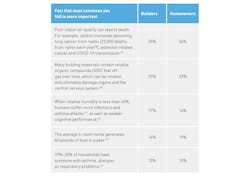Ninety percent of our time is spent indoors. Seventy percent of the time we spend is in our homes, but with the coronavirus plaguing the world over the last couple of years, that number may be even higher.
If we’re spending so much time inside, shouldn’t we be making sure the air we breathe is clean and healthy?
A recent industry survey by Panasonic looked to answer that question, as well as pose another: How healthy is my home?
BIGGEST TAKEAWAYS FROM PANASONIC IAQ SURVEY
With responses from over 600 homeowners and 150 building professionals, here are some of the key takeaways from their perspectives on indoor air quality.
A healthy home environment is just as important to homeowners as an energy efficient home.
According to the perceptions of the survey participants, builders believed homeowners were twice as likely to make energy efficiency a priority over a healthy home.
However, homeowners rated them as equal priorities (14%), under construction quality (23%), location (42%), and affordability (47%) of the home.
It’s quite possible that the rise in IAQ priority is driven by the COVID-19 pandemic. After all, we’ve seen homeowners wanting to reconnect with nature through outdoor living spaces, amenities, and biophilic design.
Builders and homeowners alike are unaware of the actual quality of air in the home.
After education on the topic of IAQ, 12% of homeowners rated the air quality in their own home as unhealthy, whereas 29% of builders said the same about most homes.
When asked what some of the best ways are to increase a healthier environment, homeowners suggested tangible factors like natural light and decluttering. Builders, on the other hand, ranked IAQ systems as a most important contributor to a healthy living environment, with almost 4 in 5 rating it very important.
After asking survey participants to identify the validity of certain IAQ statements, Panasonic found that builders were only somewhat more accurate (63% average) than homeowners (58% average).
Overall, both groups were least likely to identify that indoor air is more polluted than outdoor air, and that homes built today have less fresh air than their predecessors.
“There is no question that the building code lately has been to tighten a home,” says Kevin Smith, general manager of Life & Device Solutions Division and Visual Solutions at Panasonic. “What hasn’t been done, for the most part, is the same drive from a regulatory or industry standpoint about the importance of indoor air quality. They make energy efficient, tightly sealed homes, but the problem is you’re breathing in the same air that may be unhealthy.”
Both homeowners and builders were compelled most by facts of life-threatening health risks due to poor IAQ.
From the five health facts presented in the study (regarding asthma, dust mites, mold/mildew, VOCs, and life-threatening illnesses), IAQ became much more important to both homeowners and building professionals.
Exposure to knowledge of the facts made IAQ more important to 1 in 2 homeowners, and 2 in 3 builders.
Remember the 12% of homeowners who rated the air quality in their own home as unhealthy? After seeing the science, that number more than tripled, from 12% to 39%.
Among builders, the number who viewed most homes as unhealthy more than doubled, from 29% to 62%.
Post-exposure to the science, almost all homeowners indicated they’re more likely to invest in indoor air quality solutions.
After being educated about the risks of poor IAQ, 97% of homeowners indicated they’re more likely to invest in indoor air quality solutions.
Homeowners’ intention to purchase IAQ technologies rose dramatically on a pre-post exposure basis. Initially, only an average of 1 in 4 homeowners intended to purchase an IAQ technology; after reading the science, this rose to an average of 35%.
For builders, the likelihood of them recommending an IAQ technology to homebuyers increased by 13 points, from 49% to 62%.
This study’s biggest takeaway for the building industry? When homeowners fully realize the risks that indoor air pollution poses to their health, they’re more than ready to do something about it. Builders need to be ready to meet their needs.
According to Smith, builders can recover their investment in IAQ solutions by talking to homebuyers about its importance.
“This is our nest,” says Smith. “Indoor air quality resonates with people emotionally as much as design elements do.”
Panasonic believes that it’s time for a conversation around Indoor Air Quality—both within the homebuilding community, and between builders and homebuyers.
“We have to stop looking at health as extra credit. There’s a consumer imperative around healthy home environments. Before COVID, it was surging. With COVID, it’s on steroids. Now is a great time to move a lot of these indoor air quality solutions into the market.” — Sam Rashkin, former chief architect of the building technologies office, U.S. Department of Energy.
To read more findings of the survey, download the 18-page report using the button below.




